Modeling and Analysis of Atmospheric Composition (maac)
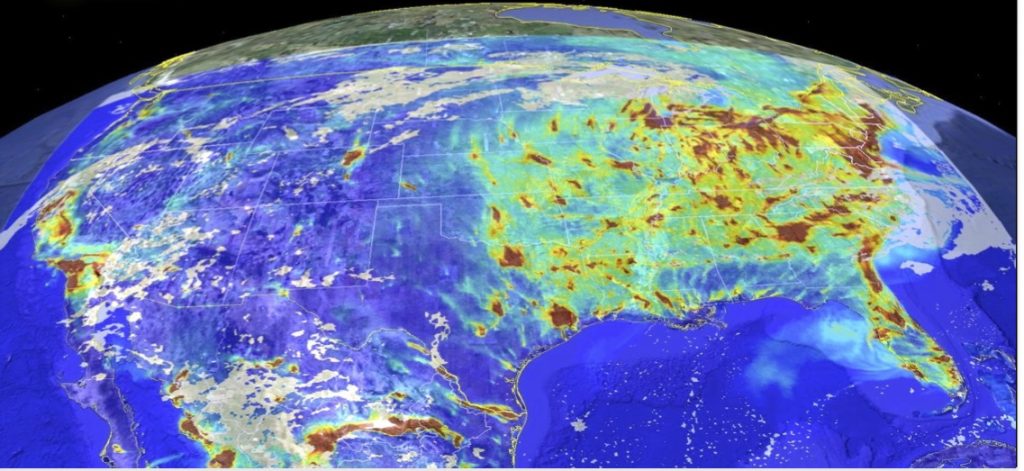
The overarching theme of my research is directed towards fully exploiting information from observations in steering numerical models and consequently improving model predictions on environmental quality.
- Data Analysis of Atmospheric Constituents
- Chemical Transport Modeling
- Chemical Data Assimilation
- OSSEs
- Inverse Modeling
- Regional to Global Air Quality
- Emerging Data Assimilation Research Frontiers
1. Data Analysis of Atmospheric Constituents
The development of a research-based numerical models of the Earth system provides a pioneering opportunity to improve our predictive capabilities on chemical weather (or air quality) and chemical climate. These models enable us to explore the full potential of an integrated prediction system that takes into account various information from environmental observations, together with the advances in modeling and computing. This is especially true with the increasing availability of satellite retrievals of atmospheric composition, which in the recent decade has been unprecedented. The goal of this core theme is to assess the value of existing retrievals of CO, CH2O, NO2, O3, CO2, CH4 and aerosol properties in: a) improving the accuracy of chemical predictions across the United States and the globe, and b) quantifying direct emissions of combustion-related species (and pollutants) from anthropogenic activities especially coming from top megacities of the world. Satellite retrievals of atmospheric composition (including GHG) are useful complements to ground-based measurement network because of its larger spatio-temporal coverage. They provide important constraints on air quality especially over poorly-observed areas around the globe. To understand the air quality over polluted areas that are mostly driven by combustion-related processes (e.g. megacities), information from retrieval of different constituents, either emitted at the same combustion process (SO2/BC/CO/CO2/NO2) or are correlated in space and time (CO/O3), can be exploited to track the sources and transport of pollution.
Related Publications:
- Mottungan, K., V. Brocchi, C. Roychoudhury, B. Gaubert, W. Tang, M.A. Mirrezaei, J. McKinnon, Y. Guo, and A.F. Arellano (2024). Local and Regional Enhancements of CO, CO2 and CH4 from TCCON, Atmospheric Measurement Techniques, [preprint], in review, https://doi.org/10.5194/egusphere-2024-705
- Roychoudhury, C., C. He, R. Kumar, J. McKinnon, and A.F. Arellano Jr (2022), On the relevance of aerosols to snow cover variability over High Mountain Asia, Geophys. Res. Lett.,49, e2022GL099317, electronic journal.
- Tang, W., A.F. Arellano, B. Gaubert, K. Miyazaki, and H. Worden (2019), Satellite Data Reveals a Common Combustion Emission Pathway for Major Cities in China, Atmos. Chem. Phys., 19, 4269-4288, 10.5194/acp-19-4269-2019, electronic journal.
- Silva, S., and A.F. Arellano (2017), Characterizing regional-scale combustion using satellite retrievals of CO, NO2 and CO2, Remote Sensing, 9(7), 744; doi:10.3390/rs9070744, electronic journal.
- Raman, A., and A.F. Arellano (2017), Spatial and temporal variations in characteristic ratios of elemental carbon to carbon monoxide and nitrogen oxides across the United States, Envi. Sci. Tech., 51(12), 6829-6838, doi:10.1021/acs.est.7b00161, electronic journal.
- Tang, W., and A.F. Arellano Jr. (2017), Investigating dominant characteristics of fires across the Amazon during 2005–2014 through satellite data synthesis of combustion signatures, J. Geophys. Res. Atmos., 121, doi:10.1002/2016JD025216, electronic journal.
- Raman, A., A.F. Arellano, and A. Sorooshian (2016), Decreasing aerosol loading in the North American Monsoon region, Atmosphere,7(2), 24;doi:10.3390/atmos7020024, electronic journal.
- Moon, Yun Seob and A.F. Arellano (2015), The characteristics of tropospheric CO2 retrieved by AIRS, GOSAT and IASI in East Asia, Disaster Advances, 8(9), 1-13, electronic journal.
- Raman, A., A.F. Arellano, and J.J. Brost (2014), Revisiting haboobs in the southwestern United States: An observational case study of the 5 July 2011 Phoenix dust storm, Atmos. Environ., 89, 179-188, 10.1016/j.atmosenv.2014.02.026, electronic journal.
- Silva, S., A.F. Arellano, and H. Worden (2013), Towards anthropogenic combustion emission from space-based analysis of urban CO2/CO sensitivity, Geophys. Res. Lett., 40, 4971–4976, doi: 10.1002/grl.50954, electronic journal.
2. Local-to-Global Chemical Transport Modeling
I am using the following models of atmospheric chemistry and transport (CTM): CalPuff, CAM-Chem, MUSICA, WRF-Chem, (and previously used CTMs such as MOZART and GEOS-Chem), as tools to understand the physical and chemical processes that control the distribution of constituents in the atmosphere and their interactions with our changing environment.
These models, while incomplete and imperfect, represent our current understanding of these processes. In conjunction with observations (remotely-sensed, ground-based, aircraft-based), these models can be made useful as a tool for research, analysis, forecasting, and assessment, in many ways motivated by the need to provide high-level information to the general public.
My earlier work focused on a study of long-range transport of Indonesian biomass burning haze in 1997/1998. I modified a limited-area model, CSIRO DARLAM (work done for my masters at National University of Singapore in collaboration with Dr. John McGregor of CSIRO Marine and Atmospheric Research) to represent the transport of emissions of constituents from fires.
Related Publications:
- Guo, Y., C. Roychoudhury, M.A. Mirrezaei, R. Kumar, A. Sorooshian and A.F. Arellano (2024), Investigating Ground-Level Ozone Pollution in Semi-Arid and Arid Regions of Arizona Using WRF-Chem Modeling, Geosci. Model Dev. Discuss. [preprint], in review, https://doi.org/10.5194/gmd-2023-234, accepted.
- Liang, J., Y. Chen, A.F. Arellano and A. Al Mamun (2021), Model Sensitivity Study of the Direct Radiative Impact of Saharan Dust on the Early Stage of Hurricane Earl, Atmosphere, 12, 1181, doi:10.3390/atmos12091181.
- Raman, A., A.F. Arellano, L.D. Monache, S. Alessandrini, and R. Kumar (2021) Exploring analog-based schemes for Aerosol Optical Depth forecasting with WRF-Chem, Atmos. Environ., 246, 118134, 10.1016/j.atmosenv.2020.118134.
- Pfister, G., S. Eastham, M. Barth, L. Emmons, D. Jacob, D. Marsh, A. Arellano, B. Aumont, K. Barsanti, A. Conley, N. Davis, J. Fast, A. Fiore, B. Gaubert, S. Goldhaber, C. Granier, G. Grell, M. Guevara, D. Henze, A. Hodzic, X. Liu, J. Orlando, J. Plane, L. Polvani, K. Rosenlof, A. Steiner, and G. Brasseur (2020), A MUlti-Scale Infrastructure for Chemistry and Aerosols – MUSICA. Bull. Amer. Meteor. Soc., doi: https://doi.org/10.1175/BAMS-D-19-0331.1.
- Tang, W., L.K. Emmons, A.F. Arellano, B. Gaubert, C. Knote, S. Tilmes, R.R. Buchholz, G.G. Pfister, G. Diskin, D.R. Blake, N.J. Blake, J.P. DiGangi, Y. Choi, J-H. Woo, C. He, J.R. Schroeder, I. Suh, H-J. Lee, H-Y Jo, Y. Kanaya, J. Jung, Y. Lee, and D. Kim (2019), Source Contribution to Carbon Monoxide Concentrations during KORUS-AQ based on CAM-Chem model applications, J. Geophys. Res., 10.1029/2018JD029151, electronic journal.
- Tang, W., Arellano, A. F., DiGangi, J. P., Choi, Y., Diskin, G. S., Agustí-Panareda, A., Parrington, M., Massart, S., Gaubert, B., Lee, Y., Kim, D., Jung, J., Hong, J., Hong, J.-W., Kanaya, Y., Lee, M., Stauffer, R. M., Thompson, A. M., Flynn, J. H., and Woo, J.-H. (2018), Evaluating High-Resolution Forecasts of Atmospheric CO and CO2 from a Global Prediction System during KORUS-AQ Field Campaign, Atmos. Chem. Phys., 18, 11007-11030, electronic journal.
- Pfister, G. G., L.K. Emmons, D.P. Edwards, A. Arellano, G. Sachse, and T. Campos, (2010), Variability of springtime transpacific pollution transport during 2000–2006: the INTEX-B mission in the context of previous years, Atmos. Chem. Phys., 10, 1345-1359, electronic journal.
- Koe, L.C.C., A.F. Arellano Jr., and J.L. McGregor, (2003), Application of DARLAM to regional haze modeling, Pure Appl. Geophys., 160, 189-204, electronic journal.
3. Ensemble-based Weather and Chemical Data Assimilation
The availability of near-global and long-term measurements of tropospheric chemical constituents from space offers an opportunity to better understand changes in tropospheric composition through the integration of measurements with predictions from global chemical transport models. Central to this integration is a chemical data assimilation system that is reasonably efficient and flexible in assimilating measurements of various scales and of various chemical species.
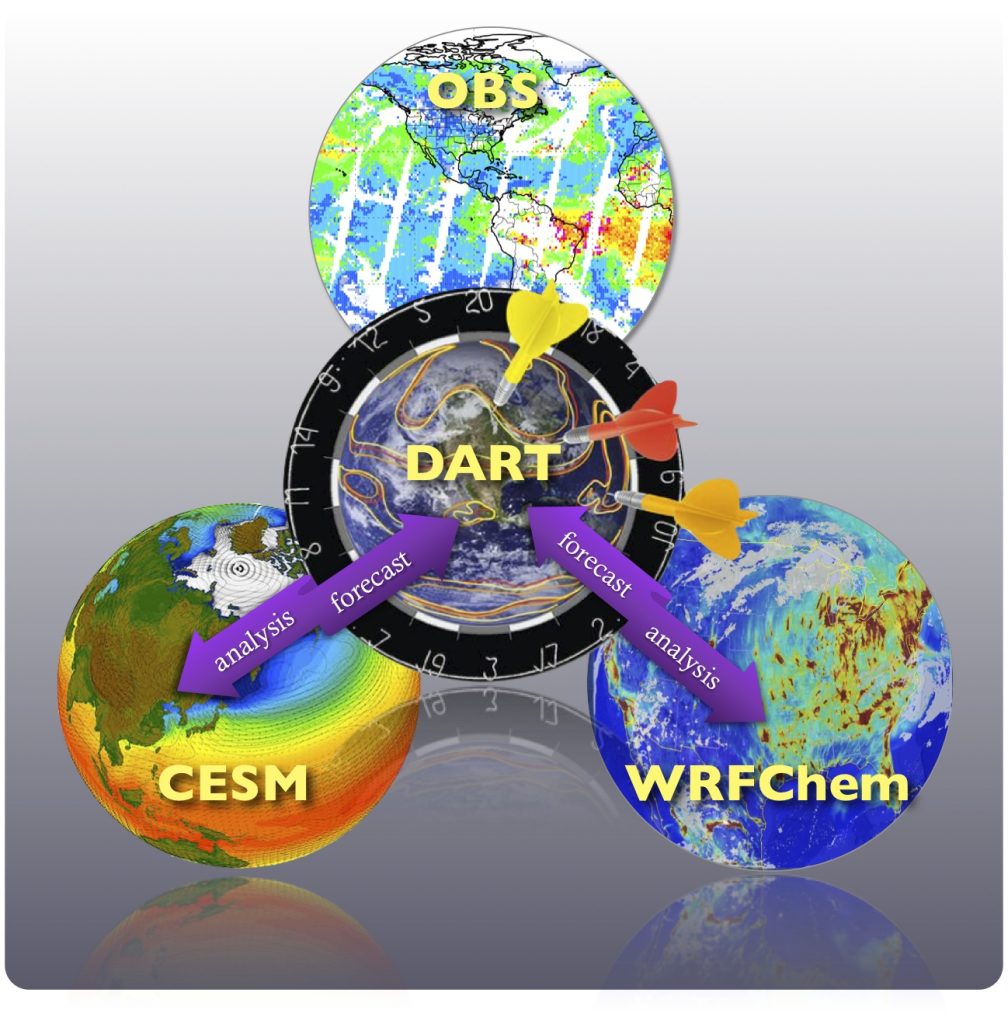
I am currently developing and implementing an ensemble-based coupled weather and chemical data assimilation system which mimics a numerical weather prediction system with chemistry. The system includes a community chemistry/climate model, the Community Atmosphere Model with Chemistry (CAM-Chem) and a community data assimilation software facility, the Data Assimilation Research Testbed (DART) both of which are being developed at the National Center for Atmospheric Research (NCAR). This directly follows the CAM/DART system being developed at NCAR Data Assimilation Research Initiative (NCAR DAReS) for atmospheric studies. This system serves as an online global chemical transport model (GCTM) with observational constraints to both meteorological fields and trace gas distribution. For this reason, it potentially offers a consistent global representation of the dynamical and chemical state of the atmosphere with an opportunity for studies related to coupling of chemistry and meteorology. To our knowledge, this type of system is one of the first applications of EnKF in global chemical data assimilation.
For air quality studies, I am also developing and implementing a regional chemical data assimilation system that includes a community chemistry/weather model, the Weather Research and Forecasting Model with Chemistry (WRF-Chem) and DART. This also directly follows the WRF/DART system being developed at NESL Mesoscale and Microscale Meteorology Division (NESL MMM) for weather-related studies.
Related Publications:
- Tang, W., B. Gaubert, L. Emmons, D. Ziskin, D. Mao, D. Edwards, A. Arellano, K. Raeder, J. Anderson, and H. Worden (2024), Advantages of assimilating multi-spectral satellite retrievals of atmospheric composition: A demonstration using MOPITT CO products, Atmos. Meas. Tech. , 17, 1941-1963, https://doi.org/10.5194/amt-17-1941-2024.
- Gaubert, B., D.P. Edwards, J.L. Anderson, A.F. Arellano, J. Barre, R. Buchholz, S. Darras, L.K. Emmons, D. Fillmore, C. Granier, J.W. Hannigan, I. Ortega, K. Raeder, A. Soulie, W. Tang, H. M. Worden, and D. Ziskin (2023), Global scale inversions from MOPITT CO and MODIS AOD, Remote Sens., 15(19), 4813; https://doi.org/10.3390/rs15194813.
- Gaubert, B., Emmons, L. K., Raeder, K., Tilmes, S., Miyazaki, K., Arellano Jr., A. F., Elguindi, N., Granier, C., Tang, W., Barré, J., Worden, H. M., Buchholz, R. R., Edwards, D. P., Franke, P., Anderson, J. L., Saunois, M., Schroeder, J., Woo, J.-H., Simpson, I. J., Blake, D. R., Meinardi, S., Wennberg, P. O., Crounse, J., Teng, A., Kim, M., Dickerson, R. R., He, H., and Ren, X. (2020), Correcting model biases of CO in East Asia: impact on oxidant distributions during KORUS-AQ, Atmospheric Chemistry & Physics, https://doi.org/10.5194/acp-20-14617-2020.
- Gaubert, B., H.M. Worden, A.F.J. Arellano, L. K. Emmons, S. Tilmes, J. Barré, S. Martinez Alonso, F. Vitt, J.L. Anderson, F. Alkemade, S. Houweling, and D.P. Edwards, (2017), Chemical feedback from decreasing carbon monoxide emissions, Geophys. Res. Lett., 44, doi:10.1002/2017GL074987, electronic journal.
- Gaubert, B., A.F. Arellano, J. Barré, H. M. Worden, L. K. Emmons, S. Tilmes, R. R. Buchholz, C. Wiedinmyer, S. Martínez-Alonso, K. Raeder, N. Collins, J. L. Anderson, F. Vitt, D. P. Edwards, M. O. Andreae, J. W. Hannigan, C. Petri, K. Strong, and N. Jones (2016), Towards a chemical reanalysis in a coupled chemistry-climate model: An evaluation of MOPITT CO assimilation and its impact on tropospheric composition, J. Geophys. Res. Atmos, 121, doi:10.1002/2016JD024863, electronic journal.
- Barré, J., B. Gaubert, A.F. Arellano, H. Worden, D. Edwards, M. Deeter, J. Anderson, K. Raeder, N. Collins, S. Tilmes, G. Francis, C. Clerbaux, L. Emmons, G. Pfister, P. Coheur, and D. Hurtmans (2015) Assessing the Impacts of Assimilating IASI and MOPITT CO Retrievals Using CESM/CAMChem and DART, J. Geophys. Res., 120, doi:10.1002/2015JD023467, electronic journal.
- Mizzi, A.P., A.F. Arellano Jr., D.P. Edwards, J.L. Anderson, and G.G. Pfister (2016), Assimilating Compact Phase Space Retrievals of Atmospheric Composition with WRF-Chem/DART: A Regional Chemical Transport/Ensemble Kalman Filter Data Assimilation System, Geosci. Model Dev., 9, 965-978, doi:10.5194/gmd-9-965-2016, electronic journal.
- Arellano Jr., A. F., P. G. Hess, D. P. Edwards, and D. Baumgardner (2010), Constraints on black carbon aerosol distribution from Measurement Of Pollution In The Troposphere (MOPITT) CO, Geophys. Res. Lett., 37, L17801, doi:10.1029/2010GL044416, electronic journal.
- Malmberg, A., A. Arellano, D. Edwards, N. Flyer, D. Nychka and C. Wikle, (2009), Interpolating fields of carbon monoxide data using a hybrid statistical-physical model, The Annals of Applied Statistics, 2(4), 1231-1248, doi:10.1214/08-AOAS168, electronic journal.
- Anderson, J.L., T. Hoar, K. Raeder, H. Liu, N. Collins, R. Torn and A. Arellano, (2009), The Data Assimilation Research Testbed: A community data assimilation facility, Bull. Am. Meteorol. Soc., 90(9),1283-1296, electronic journal.
- Arellano, A.F., K. Raeder, J. Anderson, P. Hess, L. Emmons, D. Edwards, G. Pfister, T. Campos, and G. Sachse, (2007), Evaluating model performance of an ensemble-based chemical data assimilation system during INTEX-B field mission, Atmos. Chem. Phys., 7, 5695-5710, electronic journal.
4. Observing System Simulation Experiments (OSSEs)
I am using the same ensemble-based chemical data assimilation system (NCAR CAM-Chem/DART and WRF-Chem/DART ) for studies associated with the design of current and future observing systems of the chemical states of the atmosphere. This is related to the project by Dr. David Edwards of NCAR Atmospheric Composition REmote Sensing and Prediction (ACRESP). I worked with Dr. Edwards and colleagues on an OSSE for CO in support of the NASA GEOCAPE mission.
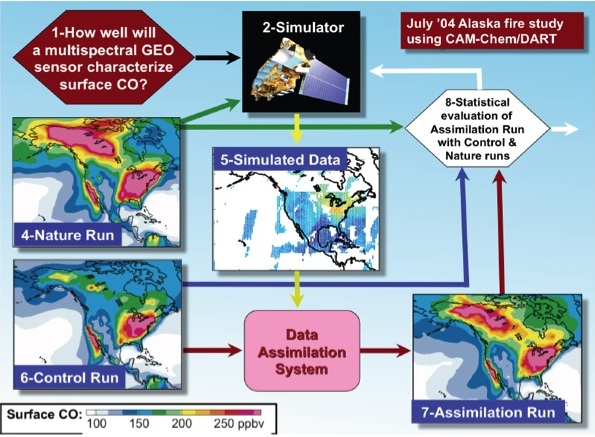
Schematic of the OSSE Framework (from Dr. David Edwards/NCAR)
Related Publications:
- Edwards, D.P., H.M. Worden, D. Neil, G. Francis, T. Valle, and A.F. Arellano Jr.(2018), The CHRONOS mission: Capability for sub-hourly synoptic observations of carbon monoxide and methane to quantify emissions and transport of air pollution, Atmos. Meas. Tech., 11, 1061-1085, electronic journal.
- Barré, J., D. Edwards, H. Worden, A. Arellano, B. Gaubert, A. Da Silva, W. Lahoz, and J. Anderson (2016), On the feasibility of monitoring carbon monoxide in the lower troposphere from a constellation of Northern Hemisphere geostationary satellites: Part II, Atmos. Environ., 140,188-201,doi:10.1016/j.atmosenv.2016.06.001, electronic journal.
- Worden, H. M., D.P. Edwards, M.N. Deeter, D. Fu, S.S. Kulawik, J.R. Worden, and A. Arellano (2013), Averaging kernel prediction from atmospheric and surface state parameters based on multiple regression with MOPITT CO and TES-OMI O3 multispectral observations, Atmos. Meas. Tech., 6, 1633-1646, doi:10.5194/amt-6-1633-2013, electronic journal.
- Edwards, D.P., A.F. Arellano, and M.N. Deeter, (2009), A satellite observation system simulation experiment for carbon monoxide in the lowermost troposphere, J. Geophys. Res.,114, D14304, doi:10.1029/2008JD011375, electronic journal.
5. Inverse Modeling of Regional to Global Sources of Atmospheric Constituents
One of my research focuses on understanding the global distribution of CO using the integration of global chemical transport forward and inverse modeling with in-situ and remote sensed measurements. One of the specific questions that is of current interest to me is the impact of biomass burning (its temporal and spatial variability) to the global distribution of CO and black carbon from large-scale fires.
My PhD dissertation under Dr. Prasad Kasibhatla of Nicholas School of the Environment, Duke University focused on developing robust, spatially and temporally resolved estimates of global CO sources using the top-down approach in direct combination with GEOS-Chem GCTM and MOPITT-derived and NOAA ESRL GMD CO measurements.
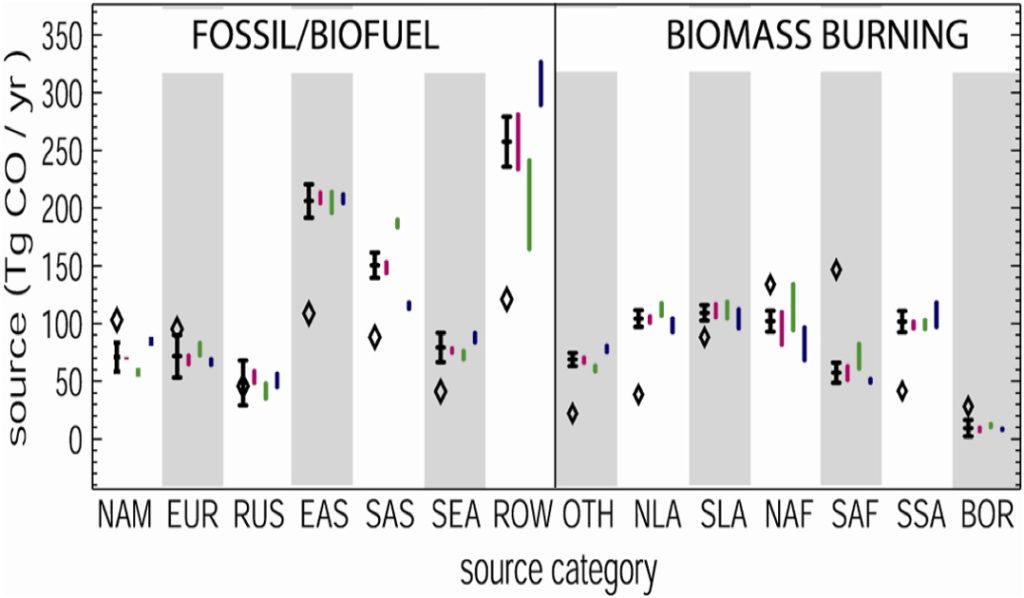
Figure 2 of Arellano et al. (2004) showing the range of top-down estimates of regional CO sources from fossil fuel/biofuel and biomass burning.
Related Publications:
- Jiang, Z., B.C. McDonald, H. Worden, J.R. Worden, K. Miyazaki, Z. Qu, D.K. Henze, D.B.A. Jones, A.F. Arellano, E.V. Fischer, L.Zhu and K.F. Boersma (2018), Unexpected slowdown of US pollutant emission reduction in the past decade, Proc Natl Acad Sci, doi:10.1073/pnas.1801191115, electronic journal, LA Times press release, Bloomberg press release.
- Jiang, Z., J. Worden, H. Worden, M. Deeter, D. Jones, A. Arellano, and D. Henze (2017), Fifteen year CO emission estimates constrained with MOPITT CO measurements, Atmospheric Chemistry and Physics, 17, 4565-4583, doi:10.5194/acp-17-4565-2017, electronic journal.
- Arellano, A.F., and P.G. Hess, (2006), Sensitivity of top-down estimates of CO sources to GCTM transport, Geophys. Res. Lett., 33, L21807, doi:10.1029/2006GL027371, electronic journal.
- van der Werf, G. R., J. T. Randerson, L. Giglio, G. J. Collatz, P.S. Kasibhatla, and A. Arellano, (2006), Interannual variability in biomass burning emissions from 1997 to 2004, Atmos. Chem. Phys., 6, 3423-3441, electronic journal.
- Arellano, A.F., P.S. Kasibhatla, L. Giglio, G.R. van der Werf, J.T. Randerson, and G. Collatz, (2006), Time-dependent inversion estimates of global biomass burning CO emissions using MOPITT measurements, J. Geophys. Res., 111, D09303, doi:10.1029/2005JD006613, electronic journal.
- Arellano, A.F., P.S. Kasibhatla, L. Giglio, G.R. van der Werf, and J.T. Randerson, (2004), Top-down estimates of global CO sources using MOPITT measurements, Geophys. Res. Lett., 31, L01104, doi:10.1029/2003GL018609, electronic journal.
- van der Werf, G.R., J.T. Randerson, G.J. Collatz, L. Giglio, P.S. Kasibhatla, A.F. Arellano, S.C. Olsen, and E.S. Kasischke, (2004), Continental-scale partitioning of fire emissions during the 1997 to 2001 El Nino/La Nina period, Science, 303, 73-76, electronic journal. See news feature.
- Kasibhatla, P.S., A. Arellano, J.A. Logan, P.I., Palmer, and P. Novelli, (2002), Top-down estimate of a large source of atmospheric carbon monoxide associated with fuel combustion in Asia, Geophys. Res. Lett., 29(19),1900, doi:10.1029/2002GL015581, electronic journal.
6. Local to Global Air Quality
I am using AQ models in conjunction with ground-based, aircraft and satellite retrievals for studies related to local to global air quality (e.g., pesticide sprays, biogenic aerosols, mineral dust, smoke from biomass burning). (effort cited in Arizona Daily Star article)
My other research interests include studies of atmospheric mercury (with Dr. Hans Friedli, formerly with NCAR ACD) and black carbon, both of which are also products of combustion-related activities.
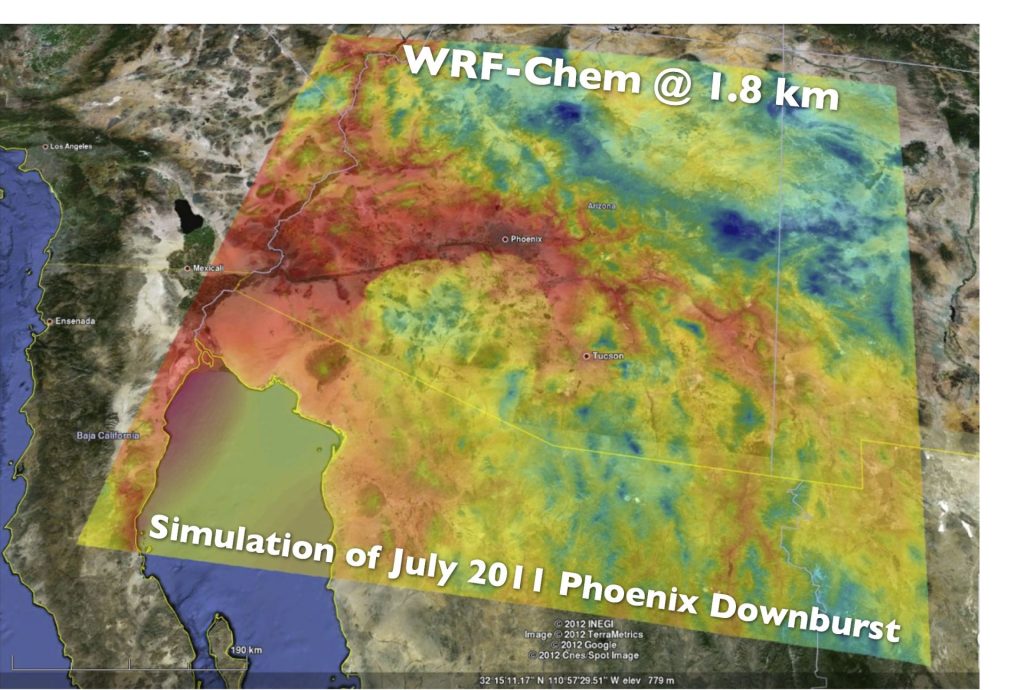
Related Publications:
- Betito, G., A. Arellano, and A. Sorooshian (2024), Influence of transboundary pollution on the variability of surface ozone concentration in the Desert Southwest of the U.S.: Case study for Arizona, Atmosphere, 15, 401, 10.3390/ atmos15040401.
- Furlong, M., K. Paul, K. Parra, A. Fournier, P. Ellsworth, M. Cockburn, A. Arellano, P. Beamer, and B. Ritz (2024), Pre-Conception And First Trimester Exposure To Pesticides And Associations With Stillbirth, Am. J. Epidemiol, accepted.
- Sorooshian, A., A.F. Arellano, M. Fraser, P. Herckes, G. Betito, E..A. Betterton, R.A. Braun, Y. Guo, M.A. Mirrezaei and C. Roychoudhury (2024), Ozone in the Desert Southwest of the United States: A Synthesis of Past Work and Steps Ahead, Environ. Sci. Tech.- Air, 10.1021/acsestair.3c0003.
- Lorenzo, G. R., Arellano, A. F., Cambaliza, M. O., Castro, C., Cruz, M. T., Di Girolamo, L., Gacal, G. F., Hilario, M. R. A., Lagrosas, N., Ong, H. J., Simpas, J. B., Uy, S. N., and Sorooshian, A. (2023), An Aerosol Climatology via Remote Sensing over Metro Manila, Philippines, Atmos. Chem. Phys., 23(18), 10579-10608, https://doi.org/10.5194/acp-23-10579-2023.
- Hilario, M.R.A., Arellano, A.F., Behrangi, A., Crosbie, E.C., DiGangi, J.P., Diskin, G.S., Shook, M.A., Ziemba, L.D., and A. Sorooshian (2024), Assessing potential indicators of aerosol wet scavenging during long-range transport, Atmos. Meas. Tech., 17, 37–55, https://doi.org/10.5194/amt-17-37-2024
- Lopez, D., M. Rabbani, E. Crosbie, A. Raman, A. Arellano, and A. Sorooshian (2015), Frequency and Character of Extreme Aerosol Events in the Southwestern United States: A Case Study Analysis in Arizona, Atmosphere, 7(1), 1; doi:10.3390/atmos7010001, electronic journal.
- Prabhakar, G., A. Sorooshian, A., E. Toffol, A.F. Arellano, and E.A. Betterton (2014), Spatiotemporal distribution of airborne particulate metals and metalloids in a populated arid region, Atmos. Environ., doi:/10.1016/j.atmosenv.2014.04.044, electronic journal.
- Youn, J.S., Z. Wang, A. Wonaschutz, A. Arellano, E.A. Betterton, and A. Sorooshian (2013), Evidence of aqueous secondary organic aerosol formation from biogenic emissions in the North American Sonoran Desert, Geophys. Res. Lett., 40, 3468-3472, doi:10.1002/grl.50644, electronic journal.
- Hyers, E.J., J. Wang, and A. Arellano (2012), Biomass Burning – Observations, Modeling, and Data Assimilation, Bull. Am. Meteorol. Soc., 93(1), ES10-ES14, doi: 10.1175/BAMS-D-11-00064.1, electronic journal.
- Friedli, H.R., A.F. Arellano, Jr., F. Geng, C. Cai and L. Pan (2011), Measurements of atmospheric mercury in Shanghai during September 2009, Atmos. Chem. Phys., 11, 3781-3788, doi:10.5194/acp-11-3781-2011, electronic journal.
- Friedli, H., A.F. Arellano, S. Cinnirella, and N. Pirrone, (2009), Mercury Emissions from Global Biomass Burning: Spatial and Temporal Distribution, in Mercury Fate and Transport in the Global Atmosphere, eds. N. Pirrone and R. Mason, Spinger, New York, p. 193-220.
- Friedli, H., A.F. Arellano, S. Cinnirella, and N. Pirrone, (2009), Initial estimates of mercury emissions to the atmosphere from global biomass burning, Environ. Sci. Technol., 43, 3507-3513, electronic journal, News Article.
- Bian, H., M. Chin, S.R. Kawa, B. Duncan, A. Arellano, and P. Kasibhatla, (2007), Sensitivity of global CO simulations to uncertainties in biomass burning sources, J. Geophys. Res., 112, D23308, doi:10.1029/2006JD008376, electronic journal.
- Koe, L.C.C., Arellano, A.F. and J.L. McGregor, (2001), Investigating the haze transport from 1997 biomass burning in southeast Asia: Its impact upon Singapore, Atmos. Envi., 35, 2723-2734, electronic journal.
7. Emerging Data Assimilation Research Frontiers (DA for the Earth System)
One of the goals of my research is to move towards the application of the DA system beyond atmospheric chemistry. In particular:
a) Boundary Layer: In collaboration with UMBC and NASA, I am currently working on innovative ways to incorporate observations of planetary boundary layer properties into numerical weather prediction systems (WRF/DART) to improve prediction of extreme weather, air quality and greenhouse gas transport.
c) Extreme Weather. In collaboration with colleagues in HAS, UW and UNAM, Im working on an NSF-funded DA research to address the need for more accurate, short-term weather forecasts during the North American Monsoon (including Arizona) by utilizing a high-resolution WRF/DART with explicit representation of convection and assimilating atmospheric water vapor derived from a network of GPS-based sensors.
b) Carbon Dynamics. In collaboration with UA/Harvard/NEON colleagues, I worked on a DOE-funded DA research using CESM/DART (CLM) to improve land surface models using a network of phenology monitoring webcams, seasonal measurements of tree growth and tree-ring based estimates of primary productivity as observational constraints.
d) Soil Moisture. I have been involved in implementing DART to assimilate the COsmic Ray Soil Moisture Observing System (COSMOS) neutron counts in the land surface model NOAH so as to improve estimates of soil moisture and heat fluxes.
Related Publications:
- Risanto, C.B., J.M. Moker, A.F. Arellano, C.L. Castro, Y. L. Serra, T.H. Luong, and D.K. Adams (2023), On the Importance of Multi-scale Constraints on Mesoscale Convective System and Precipitation Forecasts over Complex Terrain, Monthly Weather Review, https://doi.org/10.1175/MWR-D-22-0221.1.
- Risanto, C.B., C.L. Castro, A.F. Arellano, J.M. Moker, and D.K. Adams (2021), The Impact of Assimilating GPS Precipitable Water Vapor in Convective-Permitting WRF-ARW on North American Monsoon Precipitation Forecast over Northwest Mexico, Monthly Weather Review, 10.1175/MWR-D-20-0394.1, electronic journal.
- Risanto, C.B., C.L. Castro, J.M. Moker, A.F. Arellano, D.K. Adams, L.M. Fierro, and C.M. Minjarez Sosa (2019), Evaluating Forecast Skills of Moisture from Convective-Permitting WRF-ARW Model during 2017 North American Monsoon Season, Atmosphere, 10(11), 694, 10.3390/atmos10110694, electronic journal.
- Fox, A.M., T.J. Hoar, J.L. Anderson, A.F. Arellano, W.K. Smith, M.E. Litvak, N. MacBean, D.S. Schimel, and D.J.P. Moore, (2018), Evaluation of a Data Assimilation System for Land Surface Models using CLM4.5, J. Adv. Model Earth Sys., electronic journal.
- Serra, Y. L., Haase, J.S., Adams, D.K., Fu, Q., Ackerman, T.P., Alexander, M.J., Arellano, A., Back, L., Emanuel, K., Kuang, Z., Mapes, B., Neelin, D., Raymond, D., Sobel, A.H., Staten, P.W., Subramanian, A., Thompson, D.W.J., Vecchi, G., Wood, R., and P. Zuidema (2018), The Risks of Contracting the Acquisition and Processing of the Nation’s Weather and Climate Data to the Private Sector. Bulletin of the American Meteorological Society, 99(5), 869-870, electronic journal.
- Moker, J.M., C.L. Castro, Y.L. Serra, A.F. Arellano, and D.K. Adams (2018), Convective-permitting hindcast simulations during The North American Monsoon GPS Transect Experiment 2013: Establishing Baseline Model Performance Without Data Assimilation, J. Appl. Meteor. Climatol., doi:10.1175/JAMC-D-17-0136.1, electronic journal.
- Montane, F., A. Fox, A.F. Arellano, N. MacBean, R. Alexander, A. Dye, D. Bishop, V. Trouet, F. Babst, A. Hessl, N. Pederson, P. Blanken, G. Bohrer, C. Gough, M. Litvak, K. Novick, R. Phillips, J. Wood, and D. Moore (2017), Evaluating the effect of alternative carbon allocation schemes in a land surface model (CLM4.5) on carbon fluxes, pools, and turnover in temperate forests, Geosci. Model Dev., 10, 3499-3517, doi:105194/gmd-10-3499-2017, electronic journal.
- Serra, Y., D. Adams, C. Minjares-Sosa, J. Moker, A. Arellano, C. Castro, A. Quintanar, L. Alatorre, A. Granados, E. Vasqueze, K. Holub, and C. DeMets, (2016), The North American Monsoon GPS Transect Experiment 2013, Bull. Am. Meteorol. Soc., 2103-115, doi:10.1175/BAMS-D-14-00250.1.electronic journal.
- Adams, D.K., R. Fernandes, K. Holub, S. Gutman, H. Barbosa, L. Machado, R. Bennett, R. Kursinski, L. Sapucci, C. DeMets, G. Chagas, A. Arellano, N. Flilizola, A. Amorim, R. Araujo, L. Assuncao, A. Calheiros, G. Cirino, T. Pauliquevis, B. Portela, A. Sa, J. Sousa, and L. Tanaka (2015), The Amazon Dense GNSS Meteorological Network: A New Approach for Examining Water Vapor and Deep Convection Interactions in the Tropics, Bull. Am. Meteorol. Soc., electronic journal.
- Rosolem, R., T.Hoar, A.F. Arellano, J.L. Anderson, W.J. Shuttleworth, X. Zeng, and T. E. Franze (2014), Translating aboveground cosmic-ray neutron intensity to high-frequency soil moisture profiles at sub-kilometer scale, Hydrol. Earth Syst. Sci., 18, 4363-4379, electronic journal.